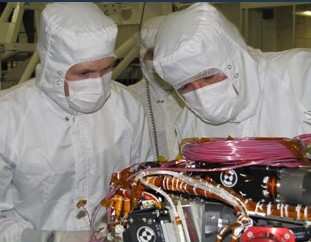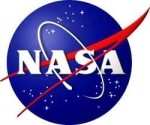APXS Will Land On Mars In August, 2012
NASA's Mars Science Laboratory rover, Curiosity, will carry a
next generation, onboard "chemical element reader" to measure the
chemical ingredients in Martian rocks and soil. The instrument is
one of 10 that will help the rover in its upcoming mission to
determine the past and present habitability of a specific area on
the Red Planet. Launch is scheduled between Nov. 25 and Dec. 18,
2011, with landing in August 2012.

APXS NASA Photo
The Alpha Particle X-Ray Spectrometer (APXS) instrument,
designed by physics professor Ralf Gellert of the University of
Guelph in Ontario, Canada, uses the power of alpha particles, or
helium nuclei, and X-rays to bombard a target, causing the target
to give off its own characteristic alpha particles and X-ray
radiation. This radiation is "read by" an X-ray detector inside the
sensor head, which reveals which elements and how much of each are
in the rock or soil.
Identifying the elemental composition of lighter elements such
as sodium, magnesium or aluminum, as well as heavier elements like
iron, nickel or zinc, will help scientists identify the building
blocks of the Martian crust. By comparing these findings with those
of previous Mars rover findings, scientists can determine if any
weathering has taken place since the rock formed ages ago.
All NASA Mars rovers have carried a similar instrument –
Pathfinder's rover Sojourner, Spirit and Opportunity, and now
Curiosity, too. Improvements have been made with each generation,
but the basic design of the instrument has remained the same. "APXS
was modified for Mars Science Laboratory to be faster so it could
make quicker measurements. On the Mars Exploration Rovers [Spirit
and Opportunity] it took us five to 10 hours to get information
that we will now collect in two to three hours," said Gellert, the
instrument's principal investigator. "We hope this will help us to
investigate more samples."

Technicians Assemble APXS NASA Photo
Another significant change to the next-generation APXS is the
cooling system on the X-ray detector chip. The instruments used on
Spirit and Opportunity were able to take measurements only at
night. But the new cooling system will allow the instrument on
Curiosity to take measurements during the day, too.
The main electronics portion of the tissue-box-sized instrument
lives in the rover's body, while the sensor head, the size of a
soft drink can, is mounted on the robotic arm. With the help of
Curiosity's remote sensing instruments – the Chemistry and
Camera (ChemCam) instrument and the Mastcam – the rover team
will decide where to drive Curiosity for a closer look with the
instruments, including APXS. Measurements are taken with the APXS
by deploying the sensor head to make direct contact with the
desired sample.
The rover's brush will be used to remove dust from rocks to
prepare them for inspection by APXS and by MAHLI, the rover's
arm-mounted, close-up camera. Whenever promising samples are found,
the rover will then use its drill to extract a few grains and feed
them into the rover's analytical instruments, SAM and CheMin, which
will then make very detailed mineralogical and other
investigations.

Scientists will use information from APXS and the other
instruments to find the interesting spots and to figure out the
present and past environmental conditions that are preserved in the
rocks and soils. "The rovers have answered a lot of questions, but
they've also opened up new questions," said Gellert. "Curiosity was
designed to pick up where Spirit and Opportunity left off."
 Classic Aero-TV: VerdeGo Debuts VH-3 Hybrid-Electric Powerplant
Classic Aero-TV: VerdeGo Debuts VH-3 Hybrid-Electric Powerplant NTSB Prelim: Grumman American Avn. Corp. AA-5B
NTSB Prelim: Grumman American Avn. Corp. AA-5B ANN's Daily Aero-Linx (12.02.25)
ANN's Daily Aero-Linx (12.02.25) Aero-News: Quote of the Day (12.02.25)
Aero-News: Quote of the Day (12.02.25) Aero-News: Quote of the Day (12.03.25)
Aero-News: Quote of the Day (12.03.25)





